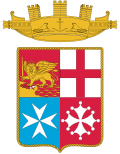This article needs additional citations for verification .(November 2016) |
| Class overview | |
|---|---|
| Name | Marino class |
| Builders | Crestitalia shipyard, Ameglia (La Spezia) |
| Operators | |
| In commission | 1985 |
| Planned | 2 |
| Completed | 2 |
| Active | 2 |
| General characteristics | |
| Type | Diving support vessel |
| Displacement | 97 t (95 long tons) full load [1] |
| Length | 25.8 m (85 ft) |
| Beam | 6.9 m (23 ft) |
| Draught | 1.2 m (3.9 ft) |
| Propulsion | 2 x Diesel engines Isotta Fraschini ID-36-SS12V (559 kW (750 hp) each) |
| Speed | 28 knots (52 km/h; 32 mph) |
| Range | 240 nautical miles (440 km; 280 mi) |
| Crew |
|
| Sensors & processing systems | 2 x GEM Elettronica SPN-753 navigation radar, X band |
| Notes | hyperbaric chamber on Alcide Pedretti |
The Marino class of diving support vessels consists of two units operated by the Italian Marina Militare. The vessels are used by Comando Subacquei Incursori (COMSUBIN) for training and operational duties and are named MAS Motoscafo Appoggio Subacquei (DSV Diving Support Vessel).
